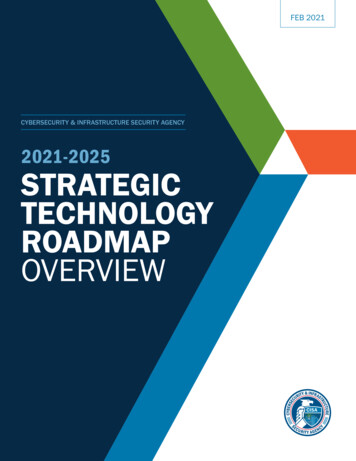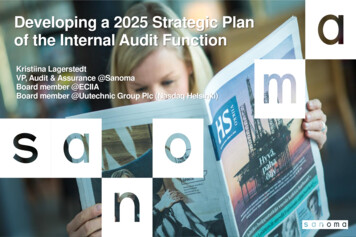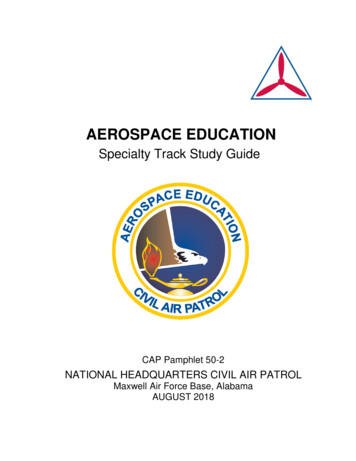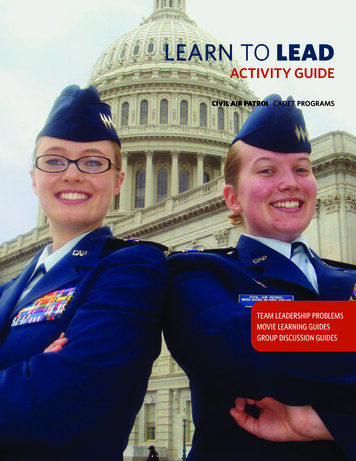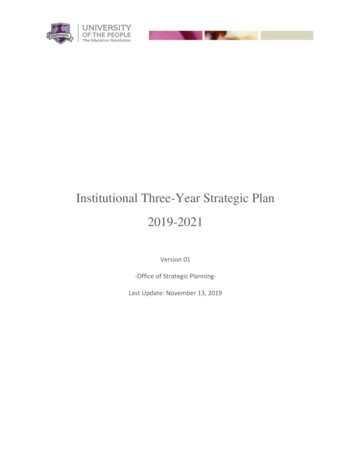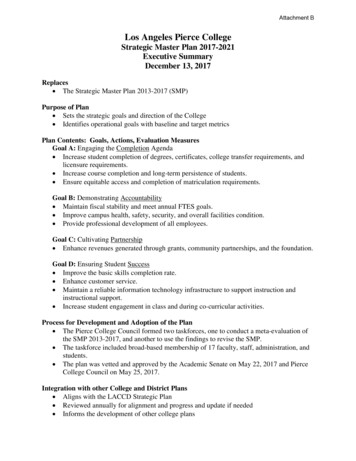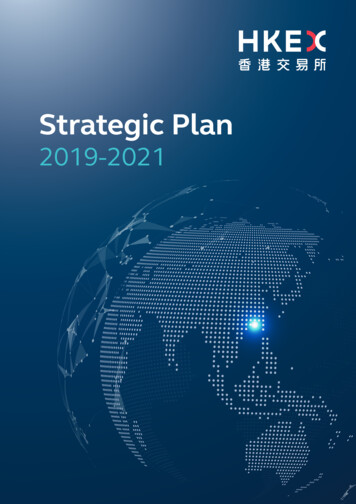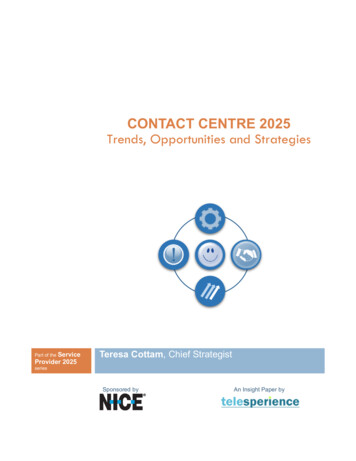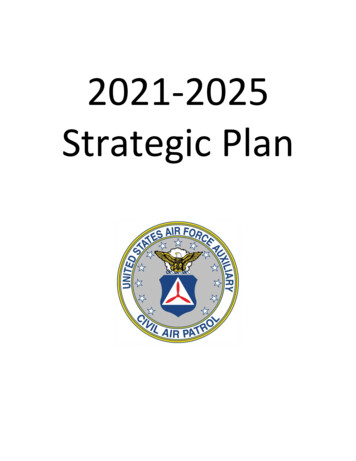
Transcription
2021-2025Strategic PlanONE CIVIL AIR PATROL, EXCELLING IN SERVICE TO OUR NATION AND OUR MEMBERS!
2
Our Strategic PlanTable of ContentsForeword . 4Developing Tomorrow’s CAP . 5We Are Civil Air Patrol. 9Our Vision Statement. 9Our Mission Statement . 9Our Core Values . 9Our Slogan and Our Motto . 9Our Purpose . 9Our Goals and Objectives . 10Alignment of Goals. 13Our Missions . 15Emergency Services . 15Cadet Programs. 16Aerospace Education . 17Beyond the Horizon . 17Our Mission Enablers . 19It All Starts With Training and Education . 19Our Equipment. 20Our Tools for Success . 20Our Competent Stewardship . 21America’s Best Kept Secret Not Anymore! . 22Reinvigorating a Rewarding CAP Experience . 23Our Members . 24Our Partners In Success . 25Our Indicators of Success . 26Appendix I – Governance . 27Annex 1 – 2021 Action Plan . 283
ForewordFellow Civil Air Patrol Airmen:Vision is what propels any organization to new heights. Strategy is the roadmap that transformsvision into reality. When we started this journey back in 2016, we developed for the first time afive-year strategic plan that sought input from all echelons of Civil Air Patrol – from the Board ofGovernors, to commanders, to every member of our amazing organization.– This is YOUR strategic plan –Strategy is a living process, adapting as needed to meet the ever-changing world and the emergingopportunities and challenges we face. Our original five-year plan is not over, however it’s nowtime to adapt to be more innovative, responsive, diverse and professional to further highlight toour partners that Civil Air Patrol is indeed the “Resource of Choice.” In addition to keeping witha rolling five-year plan, this year we’re introducing our strategic planning battle rhythm – theannual activities we’ll conduct to produce the following year’s plan. While the basic plan itselfmight not noticeably change, the annually updated action plans that implement our strategy will.When I became your National Commander, I laid out a plan of initiatives to take CAP to the nextlevel – initiatives to better care for our members and make your participation more fulfilling,improve our processes, promote our professionalism, inspire innovation, grow new partnershipsand increase our diversity. Each of these initiatives are now part of our plan.This strategic plan lays the foundation for CAP’s future, a foundation that cascades down to everyechelon. Actions taken at national, region, wing and, yes, squadron level should link to our fivegoals to complement our strategy and vision for Civil Air Patrol.It’s my privilege to serve by your side and I look forward to taking this new journey with every oneof you. Together, we can all make tomorrow’s Civil Air Patrol better than yesterday’s.MARK E. SMITHMajor General, CAPCEO and National Commander4
Developing Tomorrow’s CAPOur Civil Air Patrol has an amazing history. It all started with members of local communities answering acall to serve their nation and their neighbors. We’ve been doing this since 1941 – transforming everydaypeople into hometown heroes. Surprisingly, even though most would agree we’re not our father’s CAPanymore, our missions and principles are essentially the same as in December of 1941. Missions such ascoastal/border patrol, search and rescue, natural disaster support, air defense support, fire spotting,and flight/ground training of military members are still in our portfolio. The biggest differences betweentoday’s missions and those of our early years are the resources with which we conduct the missions, thepartners requesting our services, and the speed in which decision makers require our products.As an organization charged by Congress to serve our Nation and her communities, it’s important tosynchronize our strategic vision with that of our mission partners. Below highlights the recurring actionsnecessary for maintaining a proactive visionary strategic plan. The figures on the pages that followrecognize the various strategic plans that influenced the Civil Air Patrol Strategic Plan and how theycascade into our strategy.Figure 1 – Annual Strategic Planning Activities5
Figure 2 – A Family of Strategies6
Figure 3 – A Hierarchy of Strategies7
From the White House to each CAP Wing, select components of each subordinate plan are aligned(when applicable) to complement like elements of higher echelon strategies. Additionally, each plan hastailored elements that are applicable only to that organization. This strategic plan, along with eachwing’s strategic plan, is our vision of what we want our Civil Air Patrol to be in the future. This planserves to guide all CAP members in shaping who we are as an organization and how we’ll conduct futureprograms and missions. As our North Star, this plan aids decision making to prioritize our scarceresources, namely funding, effort and time. In essence, if an initiative does not directly contribute toone of our goals (see page 10), then the initiative should not be supported.Attached to this plan as an annex is our action plan, each task targeted to address their respective goaland synchronized over the course of this plan. If the goal is the overarching theme, then the objective isa milestone to achieve the goal and the task is the actionable item to attain the objective.We have developed tasks following the SMART principle, an acronym that represents:Specific – details what needs to be done to accomplish the objective, no guesswork as to theexpected end state; one should know if the desired task is completeMeasurable – progress or objective accomplishment can be measured, status can be determinedand tracked; delays and potential showstoppers are identifiable; enables accountabilityAttainable – don’t set the bar so high that failure is inevitable; knowing that an objective isunattainable is demoralizing to those working the taskRelevant – if the objective doesn’t contribute to goal or priority attainment, then the objectiveshould not be attempted as effort will be wastedTime Bound – completion dates should be defined and realistic; objectives stating “continue to ”are not time bound and therefore can’t really be attainedAlthough this is a rolling five-year plan, it’s not possible to accurately predict our operating environmentfive years from now. External factors such as changing levels of federal appropriations, introduction ofnew technologies and missions, or changes to laws or a partner organization’s procedures influence ourobjectives and tasks. Therefore, objectives and tasks (action plans) should be reviewed annually forrelevance by deleting, adjusting and adding new ones, when necessary.This plan is OUR vision for the future – not just the National Commander’s or the Region and WingCommanders’. Collectively, we all play a part in shaping our Civil Air Patrol of tomorrow.8
We Are Civil Air PatrolOur Vision StatementCivil Air Patrol, America’s Air Force auxiliary, building the nation’s finest force of citizenvolunteers serving America.Our Mission StatementSupporting America’s communities with emergency response, diverse aviation andground services, youth development, and promotion of air, space and cyber power.Our Core ValuesIntegrity – Volunteer Service – Excellence – RespectOur SloganOur MottoCitizens Serving CommunitiesSemper VigilansOur CredoOne Civil Air Patrol, excelling in service to our nation and our members!Our Purpose(1) To provide an organization to (A) encourage and aid citizens of the United States in contributing their efforts, services,and resources in developing aviation and in maintaining air supremacy; and(B) encourage and develop by example the voluntary contribution of private citizens to thepublic welfare.(2) To provide aviation education and training especially to its senior and cadet members.(3) To encourage and foster civil aviation in local communities.(4) To provide an organization of private citizens with adequate facilities to assist in meetinglocal and national emergencies.(5) To assist the Department of the Air Force in fulfilling its noncombat programs and missions.36 U.S.C. §403029
Our Goals and Objectives1. Strengthen national preparedness, response and resilience by leveraging CAP’s capabilities as avalued member of the Total Force. As a valued partner in the Total Force, our efforts shouldcomplement the Air Force's non-combat missions and programs, both existing and envisioned. As amember of the Total Force, it's our duty to recognize opportunities to present cost-effectivealternatives that fulfill Air Force needs.Objective 1.1: Integrate airborne, small unmanned aerial systems (sUAS) and ground imagerysystem management into one multimodal imagery program. The strategy is to define, build andexecute an integrated imagery program plan.Objective 1.2: Define/build cyber defense mission capability. The strategy is to develop cyberdefense teams at the national level to determine the feasibility and need for an expanded programnationwide.Objective 1.3: Ensure the long-term sustainability of the National Operations Support Teams. Thestrategy is to develop hosted environments (internal and external) for mission critical tools.Objective 1.4: Reinvigorate and update operations training to current standards mirroring Federalcounterparts. The strategy is to outline critical training needs and updated CAP regulations to meetcurrent standards.2. Answer America's urgent needs through aerospace education and leadership development togrow our youth into tomorrow's dynamic leaders. STEM is a priority for America, our nationalsecurity and for CAP. It remains our charge to seek out opportunities to better develop STEMminded CAP cadets and adult members, as well as, America's youth. With our eyes looking to thefuture, we must continue to develop the leaders of tomorrow's Civil Air Patrol. Our next generationof leaders will be true leaders of people with a business sense to effectively run CAP for what weare – a corporation.Objective 2.1: Reach new and underserved markets. Several strategies will be used to reach thisobjective: Reduce financial barriers that affect cadets who qualify for Free or Reduced School LunchProvide extra instructional support and mentoring to new cadetsIncrease minority participation in Cadet WingsIncrease Title I participation in AEObjective 2.2: Refresh cadet curriculum to make learning more engaging and mobile-friendly in thepost-COVID era. The strategy is to convert cadet core curriculum from textbook to interactivemodules.10
Objective 2.3: Ensure cadets are supported by adults trained in positive youth developmentpractices. Several strategies will be used to realize this objective: Focus CAP adult volunteers on key performance indicators (KPIs) that correlate with successfor the cadet mission (carry-over from 2020)Create opportunities for continuing education and specialization within the Cadet ProgramsOfficer specialty.Increase the CP community’s familiarity with the latest research & best practices in youthdevelopment3. Uphold the public’s trust through a safety-minded culture, safe environment for our members,and responsible stewardship of our valuable resources. Protecting our resources, especially ourmost valued resource – our members – is vital to the overall success of Civil Air Patrol. Ourmembers expect it as do our partners. Emphasizing safety through sound risk managementprinciples ensures that our members and assets will be ready whenever we are called to providesupport.Objective 3.1: Continue implementation of the safety management system (SMS) to fosterconsistent application of safety risk management principles across the organization. This objectivefocuses on two strategies: Develop a safety/risk aware culture across CAP for cadets and adult members, throughincreased member education, supporting appropriate risk management and SMS educationfor all levels of senior member professional developmentDevelop a data entry, storage, and retrieval system to allow analysis of mishap contributingfactors to facilitate targeted mishap reduction initiatives by mission and functionalmanagers.Objective 3.2: Reinforce a culture across CAP where members are encouraged to participate andfeel confident about CAP's programs and efforts. The strategy is to assess the current culture ofCAP.4. Model volunteerism and servant leadership as a respected nonprofit that embraces the power ofdiversity and inclusion. Diversity is a critical component of successful organizations. Ensuring thatan organization embraces, seeks and celebrates diversity brings richness to the organization.Diversity of thought, gender, ethnicity and age makes the organization stronger. A key factor toachieving broad diversity is having an organization that is inclusive – all members have the sameopportunity to participate, to be valued and to be successful. Each member joins CAP for a differentreason and just like the diversity in our membership, so too is the diversity in the contributions eachone makes, the levels they may attain in CAP and the satisfaction each receives by being a member.Objective 4.1: Diversity and inclusion: Increase diversity of the CAP membership while fostering aninclusive environment. The primary strategy is to expand and refine the CAP diversity andinclusion program.Objective 4.2: Foster an environment where volunteers from varied backgrounds have theopportunity and are encouraged to make their fullest contributions to the success of the11
organization. The strategy is to provide leadership development opportunities across the diversemembership.5. Enhance understanding of CAP’s value to America so that we can grow our organization to betterserve the Nation. Our strength resides in our membership and our members come from ourcommunities. Increasing our presence locally bolsters our recruitment and private fundraisingefforts. Additionally, our federal, state and local partners need to know the robust capabilities thatCAP delivers and that we are a cost effective, value added solution to their mission needs. State andlocal partnerships are best established at the wing and squadron level. It all starts with exploringthese new partners and introducing them to America's Civil Air Patrol.Objective 5.1: Evaluate how to better meet future needs. The strategy is to assess options toimprove CAP’s ability to deliver capabilities to mission partners and communities.Objective 5.2: Identify and communicate CAP’s value. Three separate strategies will be used inattainment of this objective: 12Develop a specialized Marketing and Communications plan to help raise awareness among akey audience essential to sustaining CAP mission capabilitiesMake a case for the expansion of funding from a variety of sourcesAddress the sustainment and expansion of funding at the Federal and State level
Alignment of GoalsDepartment of Education1. Increase College Access, Quality,and Affordability2. Improve Elementary andSecondary EducationDepartment of Homeland Security1. Prevent Terrorism and EnhanceSecurity2. Secure and Manage Our Borders4. Safeguard and SecureCyberspace5. Strengthen NationalPreparedness and ResilienceDefense Strategic Guidance5. Operate Effectively inCyberspace and Space7. Defend the Homeland andProvide Support to Civil Authorities10. Conduct Humanitarian,Disaster Relief, and OtherOperationsQuadrennial Defense Review1. Protect the HomelandCAP Goal2. Answer America's urgent needs through aerospace education and leadership developmentto grow our youth into tomorrow's dynamic leaders4. Model volunteerism and servant leadership as a respected nonprofit that embraces thepower of diversity and inclusion2. Answer America's urgent needs through aerospace education and leadership developmentto grow our youth into tomorrow's dynamic leaders4. Model volunteerism and servant leadership as a respected nonprofit that embraces thepower of diversity and inclusionCAP Goal1. Strengthen national preparedness, response and resilience by leveraging CAP’s capabilitiesas a valued member of the Total Force2. Answer America's urgent needs through aerospace education and leadership developmentto grow our youth into tomorrow's dynamic leaders5. Enhance understanding of CAP’s value to America so that we can grow our organization tobetter serve the Nation1. Strengthen national preparedness, response and resilience by leveraging CAP’s capabilitiesas a valued member of the Total Force1. Strengthen national preparedness, response and resilience by leveraging CAP’s capabilitiesas a valued member of the Total Force2. Answer America's urgent needs through aerospace education and leadership developmentto grow our youth into tomorr
Objective 3.1: Continue implementation of the safety management system (SMS) to foster consistent application of safety risk management principles across the organization. This objective focuses on two strategies: Develop a safety/risk aware culture across C
